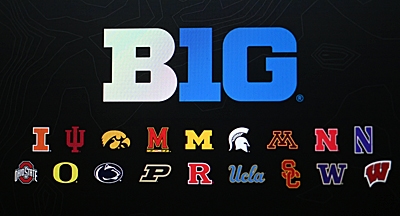
“As of now, they decided to make the rule, and we’ll have to deal with it. Nobody cares, so move on. That’s the way it goes.” – Ryan Day (Press Pros Feature Photos)
Ryan Day isn’t happy that the transfer portal is confined to early January when the Buckeyes expect to always be competing in the playoffs. But, as he has done with other changes, expect him and his staff to find a way to minimize, if not eliminate, the damage.
 Columbus, OH – Adapt to excel.
Columbus, OH – Adapt to excel.
While most college football coaches fail to manage change well, Ryan Day studies and adjusts. And then he wins – a lot.
So don’t be too worried about the latest change to college football protocols: a single fortnight of transfer portal entry from January 2-16. Last week the NCAA officially closed the spring portal entry, period.

Veteran columnist Jeff Gilbert writes Ohio State football and basketball and OHSAA sports for Press Pros Magazine.com.
Day doesn’t like the single January period because he expects his program to be a regular playoffs participant every year. Coaches in that otherwise enviable position, now must balance game preparation with recruiting transfers.
“I don’t think it’s bad for everybody,” Day said Tuesday. “I think it’s actually good for a lot of teams, but the teams that are making it late into the playoffs are really up against the 8-ball.”
Actually two 8-balls.
Playoff semifinalists and finalists will face the unknowns of who in their programs might transfer or enter the draft after their final game. Players on those teams will get an additional five-day window to enter the portal.
So, the conventional reasoning goes, if the Buckeyes play for the national title three weeks into January, they could lose players to the portal over the next five days. The replacements the Buckeyes would target – presumably some of the best players in the portal – could be off the market.
“At that point, maybe somebody will listen,” Day said. “As of now, they decided to make the rule, and we’ll have to deal with it. Nobody cares, so move on. That’s the way it goes.”
Day is correct. Nobody cares. And nobody will feel sorry for Ohio State. That’s why he says move on. He’s been doing that after every off-the-field and on-the-field change.
When NIL rules allowed players to earn money – sometimes millions – he got together with everyone he could to make sure his program would be well-funded.
When the portal opened for business and transfers no longer had to sit out a season before playing at their new school, Day embraced it for what it was. Yes, he still prefers to recruit and develop high school players, but he knows he must travel both roads. The importance of transfers Will Howard, Quinshon Judkins and Caleb Downs to last year’s national championship was immeasurable.
Those are the head coach/CEO parts of Day’s job that he has adjusted to well. Now he will meet with his ever-growing cabinet of coaches, directors and advisors with one goal. How do we win the transfer portal’s new normal?
If more staff members are required to keep the Buckeyes at the top, you can bet athletic director Ross Bjork will find money in the budget.
If readjusting priorities for certain people in January is necessary, Day will insist on it.
Despite these perceived disadvantages, Day has one advantage over everyone else in the Big Ten and probably the entire breadth of the Power 4 conferences. He coaches at Ohio State. Players want to play for the Buckeyes, and play for Day.
The high-level players who enter the portal on January 2 don’t have to be in a hurry to choose. If they desire to wait and see if the fit is right depending on what happens with the Buckeyes’ roster after the playoffs, they will play the long game. If they don’t, maybe they were in the portal for money more than championships.
The removal of the spring portal period feels like a reaction to the feelings that too many players are transferring. That’s how the Buckeyes got defensive end Beau Atkinson from North Carolina. He entered after spring practice and has brought needed depth to the front four.
However, no after-spring practice portal doesn’t prohibit players from transferring then. Though not nearly as common, any player is free to withdraw from a school and enroll at another without going through the portal process. That practice is likely to increase.
Day’s adaptive tendencies have also been at work on the field.
Style points mattered when the playoff was limited to four teams. That meant worrying about things like game control and always pushing for explosive plays. In those days, Day wanted to rush for 200 yards and run up big scores by halftime.
In the 12-team playoff era, Day doesn’t focus on those eye-pleasing things as much as he used to.
The pace of play in the college game has also changed his thoughts on the numbers his offense produces. The helmet communication with the quarterback has brought the huddle back and reduced the number of plays significantly. The clock also stops less because of other rule changes.
 Questions, of course, persist about the running game numbers, big pass plays and points scored. Ask Day about balancing those things, and he almost always starts as he did Tuesday.
Questions, of course, persist about the running game numbers, big pass plays and points scored. Ask Day about balancing those things, and he almost always starts as he did Tuesday.
“The first goal is to win,” he said. “When you look at it from that point of view, you do everything you can to win that game. But then you take a step back and figure out what gives us the best chance to reach our goals, and that’s the way we look at it.”
Day’s ultimate off-field goal remains to attract great players, players who fit his hardest-playing-team-in-America culture, players who want to be Buckeyes. That is non-negotiable. He will simply adjust a little bit – with the help of a motivated staff – to get all the players necessary to keep playing into January.
Adapt and excel. Ryan Day knows how to survive.





